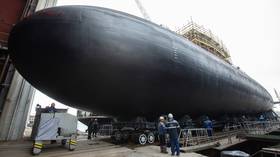Air Force says it can't fund health study after poisoning water around its base

The US Air Force says it has no authority to pay for a study into the health effects of cancer-associated chemicals it spilled into the drinking water around the now-closed Pease Air Force Base in New Hampshire.
This week, the Air Force told concerned residents of southeast New Hampshire that, despite the service's responsibility for chemicals known as perfluorinated compounds (PFCs) found in the Haven Well at the former Pease Air Force Base, it cannot fund a study on the chemicals' impact on adults and children in the area.
Lieutenant Colonel Joseph Constantino told a meeting of the Pease Community Assistance Panel, a group interested in seeing the studies come to fruition, that the Air Force's lawyers said "we can't fund the study" based on a professed lack of authority.
AirForce Brass "our attorneys say we're not authorized to spend $ on ur health concerns @mindimessmer4nh@stefanyshaheen@DennisMalloy1pic.twitter.com/EajhY2RyVs
— Rebecca McBeath (@BeckyMcBeath) May 30, 2017
"We don't have authority to go into that kind of work," he said, according to Military.com. " ... Without authority, there's no funding."
The Air Force had previously funded a feasibility assessment, released in April, to determine whether health studies could be conducted at Pease. At the meeting, area residents chafed over the service's current refusal to pay for these studies, calling the announcement a disappointment.
Andrea Amico's response to the @usairforce refusal to pay for Pease health studies https://t.co/C88rkRNzmG#unacceptable#takeresponsibility
— Testing for Pease (@Testing_4_Pease) June 1, 2017
"The fact we've gone through this whole process with the ATSDR for a year," only to find out the Air Force won't pay for the study, is "frankly unacceptable,"said Andrea Amico, a leader of the residential effort to compel the studies.
"The Air Force needs to take responsibility for this," Amico added.
Constantino was joined by the director and a senior epidemiologist with the Agency for Toxic Substances and Disease Registry (ATSDR), a federal health entity that hosted the meeting. ATSDR officials echoed the refrain that there was not enough money to fund the New Hampshire studies, estimated to cost about $25 million total.
Instead, the ATSDR acknowledged a "a national-scale problem" related to PFCs.
"It’s going to require a national commitment to this," said Pat Breysse, director of the ATSDR. "We recognize this is a national-scale problem and we are also working with other affected communities ... but we don’t have the authority and we don’t have the resources."
The agency has an annual budget of about $75 million.
Perfluorooctane sulfonate (PFOS), perfluorooctanoic acid (PFOA) and perfluorohexane sulfonate (PFHxS) – all of which are PFCs – were discovered at the Haven Well in 2014, according to the New Hampshire Union Leader. The well supplied about half of all drinking water at Pease International Tradeport, the site of the former air force base and of the current Portsmouth International Airport. PFOS levels were found to be 12.5 times higher than federal health limits.
The chemicals have been detected at current and former military bases where firefighting training exercises have been conducted. Like at other bases, firefighting foam used at the base in decades past contained the chemicals.
PFCs were commonly used in the past to develop an array of industrial and commercial products, such as furniture fabrics and non-stick cookware. The chemicals have been linked with increased risk for some types of cancer, including testicular and kidney cancers, as well as hormone disruption, decreased fertility and obesity.
The Haven Well was closed in 2014 after PFCs were discovered. In 2015, the state health department began blood-testing volunteers who may have been affected by the contamination. The tests found above average levels of the three PFCs in those tested, the Union Leader reported.
Residents at the meeting with the Air Force and the ATSDR said they were "perplexed" by the service's announcement.
"If you folks had no intention of funding studies, you should have made that clear a lot sooner in the process," Amico said. "We're not going away," she added, according to the Union Leader.
Banned chemicals contaminate groundwater near US bases on #Okinawahttps://t.co/H0nW17qnxUpic.twitter.com/jlATGa1dkh
— RT America (@RT_America) April 18, 2017
In May 2016, the US Environmental Protection Agency called PFCs"contaminants of concern," significantly lowering the accepted levels of PFOA and PFOS that can exist in sources of drinking water.
"While consumer products and food are a large source of exposure to these chemicals for most people, drinking water can be an additional source in the small percentage of communities where these chemicals have contaminated water supplies," the EPA said. "Such contamination is typically localized and associated with a specific facility, for example, an industrial facility where these chemicals were produced or used to manufacture other products or an airfield at which they were used for firefighting."
The US Defense Department said last year that it was analyzing hundreds of its sites and installations around the US for possible contamination related to the old firefighting foam. In August of 2016, the Air Force said it was switching to an "environmentally responsible" foam used to extinguish fires.













